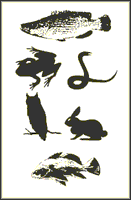Nebraska Cooperative Fish & Wildlife Research Unit
ORCID IDs
Sarah A. Sonsthagen https://orcid.org/0000-0001-6215-5874
Robert E. Wilson https://orcid.org/0000-0003-1800-0183
Date of this Version
2022
Citation
Sonsthagen, S., Wilson, R. E., Talbot, S. L. (2022). Species-specific responses to landscape features shaped genomic structure within Alaska galliformes. Journal of Biogeography. 2022;49:261–273.
Abstract
Aim: Connectivity is vital to the resiliency of populations to environmental change and stochastic events, especially for cold-adapted species as Arctic and alpine tundra habitats retract as the climate warms. We examined the influence of past and current landscapes on genomic connectivity in cold-adapted galliformes as a critical first step to assess the vulnerability of Alaska ptarmigan and grouse to environmental change. We hypothesize that the mosaic of physical features and habitat within Alaska promoted the formation of genetic structure across species.
Location: Alaska, United States of America.
Taxa: Ptarmigan and Grouse (Galliformes: Tetraoninae).
Methods: We collected double digest restriction-site- associated DNA sequence data from six ptarmigan and grouse species (N = 13–145/ species) sampled across multiple ecosystems up to ~10 degrees of latitude. Spatial genomic structure was analysed using methods that reflect different temporal scales: (1) principal components analysis to identify major trends in the distribution of genomic variation; (2) maximum likelihood clustering analyses to test for the presence of multiple genomic groupings; (3) shared co-ancestry analyses to assess contemporary relationships and (4) effective migration surfaces to identify regions that deviate from a null model of isolation by distance.
Results: Levels of genomic structure varied across species (ΦST =0.009–0.042). Three general patterns of structure emerged: (1) east-west partition located near the Yukon-Tanana uplands; (2) north-south split coinciding with the Alaska Range and (3) northern group near the Brooks Range. Species-specific patterns were observed; not all landscape features were barriers to gene flow for all ptarmigan and grouse and temporal contrasts were detected at the Brooks Range.
Main conclusions: Within Alaska galliformes, patterns of genomic structure coincide with physiographic features and highlight the importance of physical and ecological barriers in shaping how genomic diversity is arrayed across the landscape. Lack of concordance in spatial patterns indicates that species behaviour and habitat affinities play key roles in driving the contrasting patterns of genomic structure.
Included in
Aquaculture and Fisheries Commons, Environmental Indicators and Impact Assessment Commons, Environmental Monitoring Commons, Natural Resource Economics Commons, Natural Resources and Conservation Commons, Water Resource Management Commons


Comments
U.S. government work